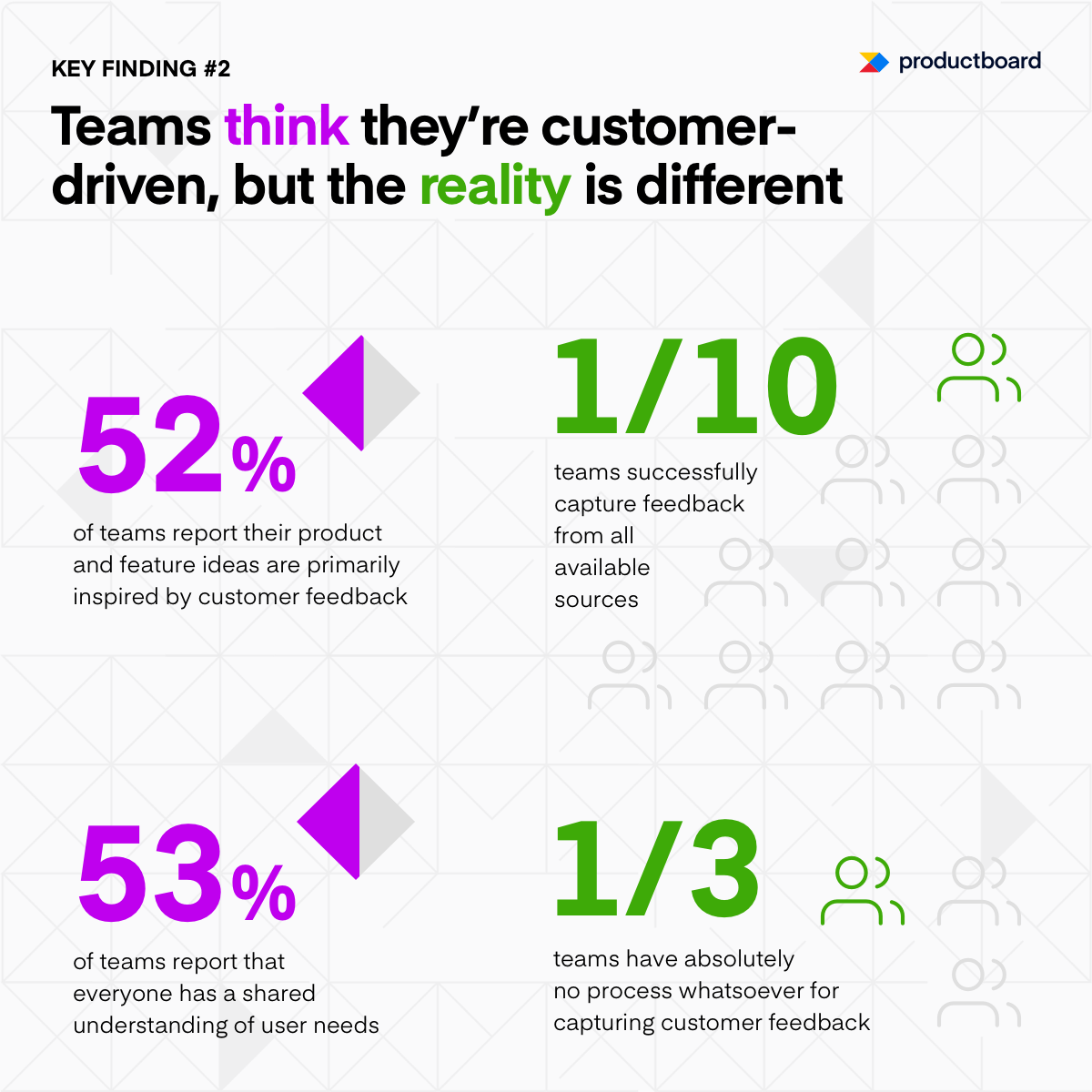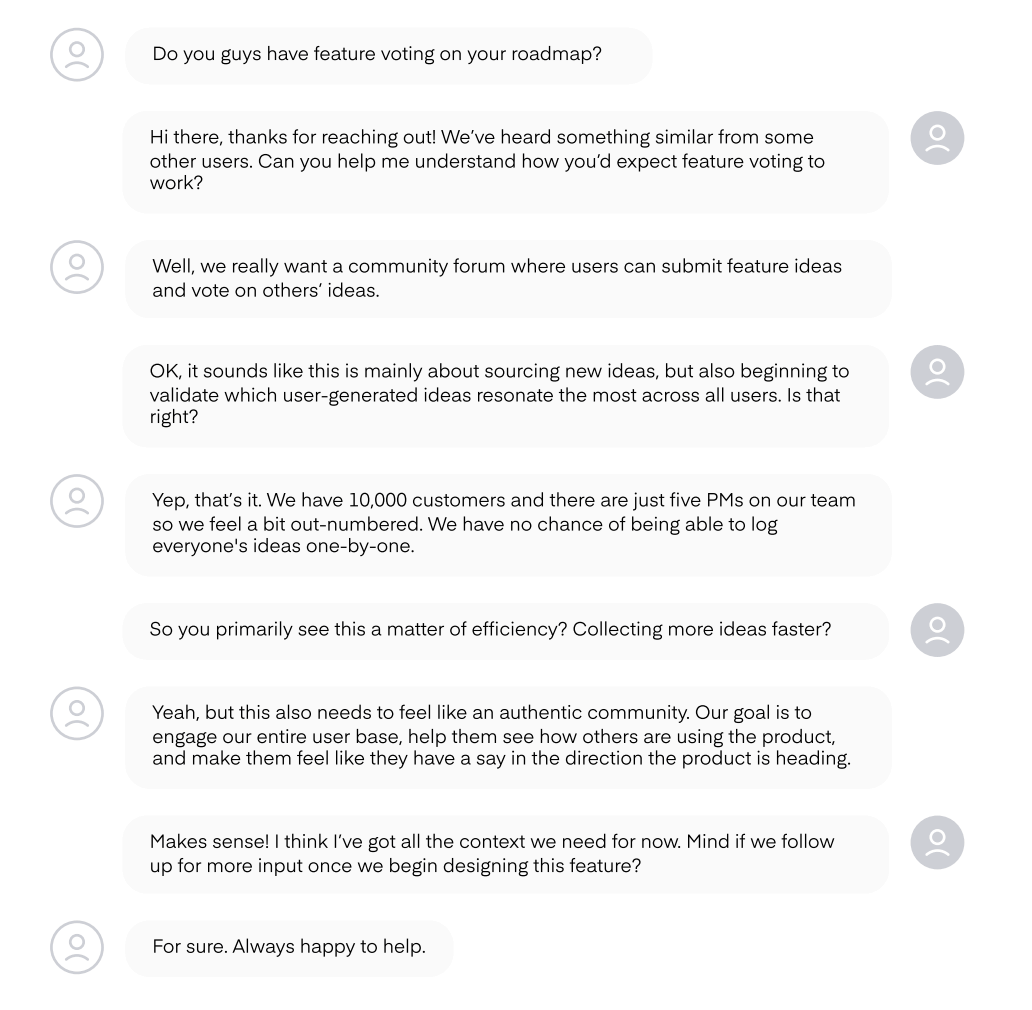Deep customer insights: The key to building excellent products

This post was originally published in Destination CRM.
Shipping early and iterating toward success might have been enough for product teams to survive in the past—but getting the right products to market faster is only becoming more challenging.
In the software market, cloud infrastructure, modular platforms, and off-the-shelf SaaS solutions let new entrants reach thousands of customers in months instead of years. Teams can no longer afford to spend weeks or months building features that solve incidental problems while competitors nip at their heels.
Customers have evolved as well, demanding ever more personalized user experiences tailored to their individual needs. As businesses grow more personal—and more quickly—there will be an increasing number of customer conversations from which teams can draw valuable insights.
The problem? Managing the ever-growing volume of desires and demands only becomes more difficult as organizations scale. Only 1 in 10 teams successfully capture feedback from all available sources—and even more worrying, 1 in 3 do not have any process whatsoever for capturing customer feedback.

Modern product organizations must put themselves into the shoes of the customers. Achieving Product Excellence means leveraging every conversation and interaction that the broader company has with the market to get the right products to market, faster.
Diverse conversations lead to deep user insights
Companies are like a living organism. Just as the human body has different senses, different groups across your organization bring different strengths to the product development process:
- Product managers perform user research and gather feature requests.
- Salespeople are on the front lines talking with prospects about their needs.
- Customer support reps collect support tickets and field customer complaints.
- Customer success teams analyze wins and losses to improve retention.
- Product marketers keep their eyes trained on the competition.
The larger the company, the more diverse your market interactions—with existing customers, with prospects, even with sales lost to competition or churn. In the same way our richest experiences impact us in a multi-sensory manner, bringing these teams and their insights together means organizations can achieve far more in less time.
Product teams must make a habit of interfacing not only with customers, but with customer-facing teams as well. Consider all the different touchpoints that people at your company have with end users and understand the places where you currently gather insights. Each conversation, support ticket, and NPS report is an opportunity to uncover deep user insights that drive Product Excellence.
Gathering feedback is everyone’s responsibility
Running interviews with customer-facing teams to share, rank, and elaborate on user needs can yield many gold nuggets of actionable information.
But customer feedback management needs to be scalable. It simply isn’t feasible to expect product managers to read every support ticket or record every sales conversation.
Managing the sheer magnitude of information gathered across such diverse teams—let alone sifting through the information to uncover valuable insights—often seems insurmountable. The key to scale: Product makers must build a culture around gathering feedback.
Instead of product managers taking sole responsibility for the heavy lifting, gathering and organizing feedback must become everyone’s responsibility. Collecting feedback in a central location ensures the handful of high-value insights aren’t missed and can be properly categorized and prioritized by the product team.
Teams striving for Product Excellence should begin by creating a central repository to consolidate product inputs from all sources. Each time you receive feedback, have your team capture it in your repository, along with contextual information such as:
- From which customer and customer segment does each piece of feedback originate?
- How frequently is this request being made?
- How great of an impact would this request have on our customers?
- To which customer need or to which part of your product does it relate?
Your feedback repository can be as simple as a shared spreadsheet, but user-centered product management tools simplify customer feedback management, funneling inputs from across the organization and syncing with the other tools in your stack.
Linking structured feedback with insights in this way ensures product teams can quickly identify who they should talk to as they dig deeper into customer needs, allocate development resources to the most valuable request, and be strategic in their work instead of being predestined to work on everything at the same time.
Turn deep user insights into excellent products
Customers are often opinionated about your product. Unfortunately, they’re usually wrong.
When customers ask for a feature, they usually envision solutions based on their own needs and prior knowledge. That often means customers provide tactical suggestions—feedback that only leads to incremental improvements.
To understand what users truly need, you can’t rely on customers to explain their needs to you—you must sleuth them out yourself. Repeated conversations, shared frustrations, and common complaints among shared customer demographics all indicate important customer problems you can solve within your product.
Identifying customer needs begins by asking “why” five times. For each piece of feedback, ask why it’s important, then ask why again, and sometimes a third or fourth time. Each follow-up question you ask should serve to dig beneath surface-level problems to uncover the core user needs at play.

Customer feedback management gives teams the information they need to understand “why,” unlocking those hidden insights that take teams from reactive assumptions to proactive strategy. Half of all product teams don’t feel their roadmaps reflect user needs. Teams that make assumptions rather than relying on data spend weeks, months, or even years working on products or features that end up underutilized or ultimately fail in the market.
The key to launching successful products? A deep understanding of customer needs
Modern sales and marketing teams have always entrusted powerful CRM platforms to collaborate with customers and close deals. But product teams have traditionally been left hanging, relying on static spreadsheets and disjointed feedback forms to drive their work.
Given the importance of their work, that represents a missed opportunity for many companies. Delivering the right products to market faster requires the adoption of new technologies, concrete processes, and a customer-oriented mindset—a process which begins with gaining a deep understanding of customer needs.
Fortunately, modern product management tools are quickly closing this gap. Think of a product management platform as the “brain” bringing together and coordinating the different strengths and insights from across your organization.
With the right tools and systems in place, any organization can deliver the right products to market faster, exceed customer expectations, and make something truly excellent.




